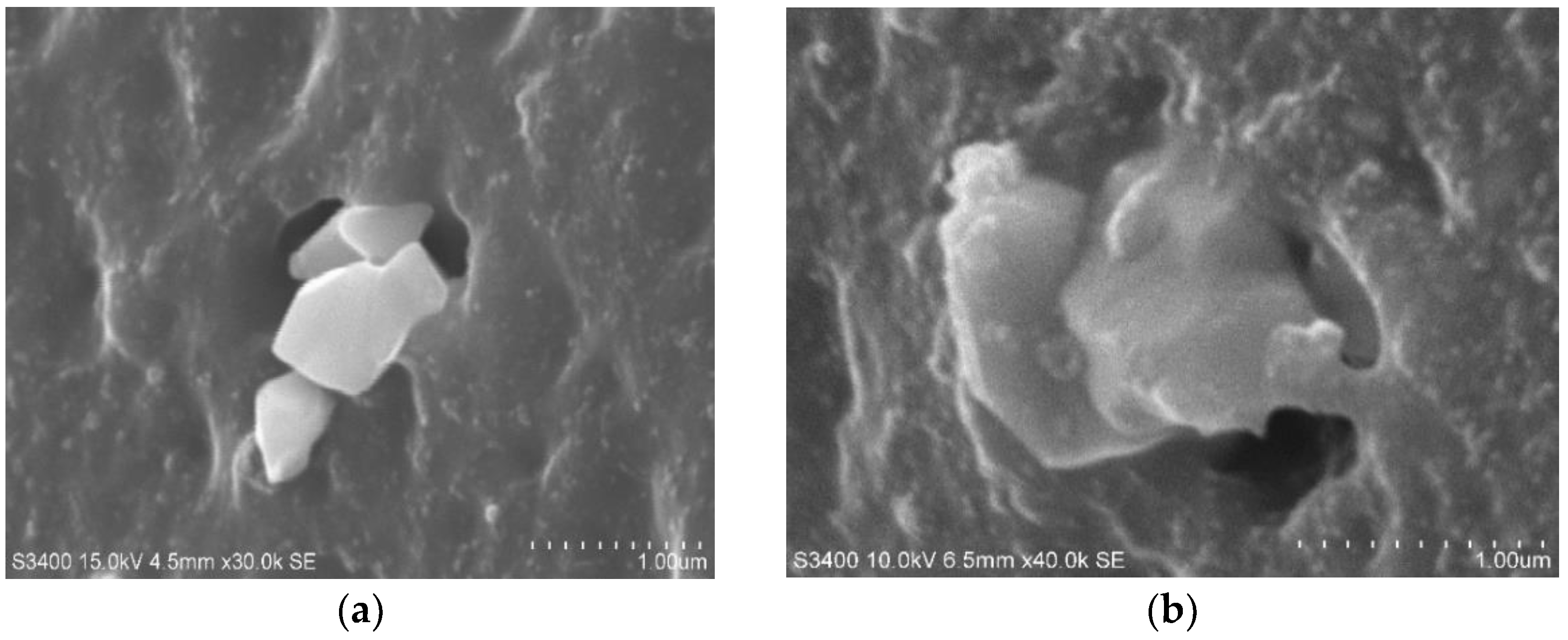Polymer composites have been at the forefront of research in recent decades as a result of the unique properties they provide for utilization in numerous applications.
The factors affecting the manufacturing of a smart composite includes the choice of ingredients such as polymer, filler and additives as well as their unique composition [
1]. These include polymers (modification, blending, general/engineering/super engineering plastic), rubber (natural rubber (NR), EPDM, silicone, TPE, specialty rubber), fibers (size, shape, dispersion/distribution, reinforcement, electrical/thermal conduction, biodegradable, cellulose-, glass-, carbon-, graphene-, aramid-, etc.), and additives (synergistic/antagonistic, anti-degradation, interfacial-adhesion, silane hybrid composites) [
2,
3]. An example of interfacial adhesion is bifunctional silane [e.g., bis(triethoxysilyilpropyl)disulfide (TESPT) and bis(triethoxysilyilpropyl)tetrasulfide (TESPD)] in a silica-filled rubber system. In the silica filled system, bifunctional silane chemically bonds silica and NR, and not only assists in the dispersion of silica agglomerates in the rubber chain [
4,
5], but also increases the interfacial interaction between the two materials by chemical bonding [
6].
Figure 1 shows the TESPT effect on chemical bonding between silica and NR. Silanes represent smart materials, which change the properties of rubber and plastic composites significantly, as shown above. It was applied for smart/green tire composites, anti-vibration rubber composites, and plastic composites [
7,
8].
Additionally, the smart processing of polymer composites improves the construction of polymer composites, which is influenced by the choice of mixers, processing condition, processing technique, use of a 3D printer, etc. These include the mixing mechanisms [mixer (internal/open), intermeshing/tangential type (rotor type and screw configuration), reactive mixing (temperature/speed at each stage, curing condition (pre/post), mixing sequence, mold design and molding technique (filler orientation, simulation, pre-treatment (chemical, thermal…)) etc.] [
4,
5,
9,
10,
11,
12,
13].
These contribute to the construction of advanced polymer composites for high-performance automotive and aerospace parts, advanced electronic devices, environmentally friendly goods, sensors, and other such uses.
“Smart Composites and Processing” is a newly opened Special Issue (SI) of Polymers, which aims to publish original and review papers on the new scientific and applied research and make boundless contributions to the findings and understanding of various smart composites and smart processing.
Funding
This research received no external funding.
Conflicts of Interest
The authors declare no conflict of interest.
References
- White, J.L.; Kim, K.J. Thermoplastic and Rubber Compounds Technology and Physical Chemistry; Hanser Publisher: Munich, Germany; Cincinnati, OH, USA, 2008. [Google Scholar]
- Plueddemann, E.P. Silane Coupling Agents; Plenum Press: New York, NY, USA, 1982. [Google Scholar]
- Gupta, R.K.; Kennal, E.; Kim, K.J. Polymer Nanocomposites Handbook; CRC Press: Boca Raton, FL, USA, 2009. [Google Scholar]
- Kim, K.J.; White, J.L. Silica Agglomerate Breakdown in Three-Stage Mix Including a Continuous Ultrasonic Extrude. J. Ind. Eng. Chem. 2000, 6, 372–379. [Google Scholar]
- Kim, K.J.; White, J.L. TESPT and Different Aliphatic Silane Treated Silica Compounds Effects on Silica Agglomerate Dispersion and on Processability During Mixing in EPDM. J. Ind. Eng. Chem. 2001, 7, 50–57. [Google Scholar]
- Kim, K.J. Silane effects on in-rubber silica dispersion and silica structure (α(F)): A Review. Asian J. Chem. 2013, 25, 5119–5123. [Google Scholar] [CrossRef]
- Ryu, C.S.; Kim, K.J. Interfacial Adhesion in Silica-Silane Filled NR Composites: A Short Review. Polymers 2022, 14, 2705–2719. [Google Scholar] [CrossRef] [PubMed]
- Lee, J.Y.; Kim, K.J. MEG effects on hydrolysis of polyamide 66/glass fiber composites and mechanical property changes. Molecules 2019, 24, 755–765. [Google Scholar] [CrossRef] [PubMed]
- Wolff, S. Reinforcing and Vulcanization Effects of Silane Si69 in Silica-Filled Compounds. Kautsch. Gummi Kunstst. 1981, 34, 280–284. [Google Scholar]
- Wolff, S. Optimization of Silane-Silica OTR Compounds. Part 1: Variations of Mixing Temperature and Time during the Modification of Silica with Bis-(3-Triethoxisilylpropyl)-Tetrasulfide. Rubber Chem. Technol. 1982, 55, 967–989. [Google Scholar] [CrossRef]
- Isayev, A.I.; Hong, C.K.; Kim, K.J. Continuous Mixing and Compounding of Polymer/Filler and Polymer/Polymer Mixtures with the Aid of Ultrasound. Rubber Chem. Technol. 2003, 76, 923–947. [Google Scholar] [CrossRef]
- Kim, K.J.; VanderKooi, J. Reactive Batch Mixing for Improved Silica-Silane Coupling. Int. Polym. Process. 2004, 19, 364–373. [Google Scholar] [CrossRef]
- Kim, S.M.; Cho, H.W.; Kim, J.W.; Kim, K.J. Effects of processing geometry on the mechanical properties and silica dispersion of silica-filled isobutylene-isoprene rubber (IIR) compounds. Elastomers Compos. 2010, 45, 223–229. [Google Scholar]
Short Biography of Author
K. J. Kim received his M.S. in Chemical Engineering in 1987 at INHA U. in S. Korea and Ph.D. in Polymer Engineering in 1998 at the University of Akron, USA. He was then a Post-Doctoral Fellow at Institute of Polymer Engineering (IPE) at U. Akron (1997–1999). Then, he joined to Struktol Company of America as a Research Scientist/Project Manager of Polymer Processing and Additives R&D (2000–2005). Next, he joined West Virginia University in Chemical Engineering as a Research Assistant Professor (2006–2007). He then worked at the Gyeongsang Nat’l U. in Polymer Sci. and Eng. Dept. as a Brain Pool Research Professor, after being invited by the Korean Government (2008–2009). He then joined Dong Ah Tire & Rubber Co., Ltd. (one division of DTR Co.) as a Chief Technical Officer and moved to Polymer R&D Center at DTR Co. as an R&D Head (2010–2019). He then joined DTR VMS Italy S.r.l. in the Material R&D Division as Head/Vice President (2019–2020). His professional interests are thermoplastic and rubber compounds, polymer nanocomposites, interfacial science, reactive processing, rheology, morphology, structure-property relationships, chemical additives, nano materials, and synthesis (organic and inorganic hybrid materials). He published three Books (English (2) and Chinese (1)) (1) “Thermoplastic and Rubber Compounds: Technology and Physical Chemistry”, Hanser Publisher, Munich, Cincinnati [Co-author with J. L. White] (2008), (2) “Polymer Nanocomposites Handbook” CRC Press, Boca Raton, [Co-author with Rakesh K. Gupta and Elliot Kennel] (2009), (3) [Annotated version of “Polymer Nanocomposites Handbook” CRC Press], 78 peer review papers, and filed 11 patents.
| Publisher’s Note: MDPI stays neutral with regard to jurisdictional claims in published maps and institutional affiliations. |
© 2022 by the author. Licensee MDPI, Basel, Switzerland. This article is an open access article distributed under the terms and conditions of the Creative Commons Attribution (CC BY) license (https://creativecommons.org/licenses/by/4.0/).





